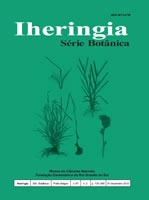Diversity and panbiogeographic analysis of Lycophytes (Embryopsida: Lycopodiidae) from Calilegua National Park, Jujuy, Argentina.
Keywords:
Yungas, Lycopodiaceae, Selaginellaceae, biogeography, diversityAbstract
The lycophyte taxa of the Parque Nacional Calilegua are reported and their biogeographical relationships are established employing a panbiogeographic analysis. Nine species classified in two families (Lycopodiaceae and Selaginellaceae)are registered. The most diverse genera are Phlegmariurus and Selaginella. The individual tracks and the generalized track indicate that this zone is part of the Neotropical biotic component, Which ends at the central hills of Argentina. The generalized track borders the South American Transition Zone that represents a successful barrier for lycophytes and also separates the Andean and Neotropical regions.Furthermore, the region of the Parque Nacional Calilegua is closely related to the Parana subregion,overcoming the arid barrier represented by the Chacoan subregion, a pattern that is supported by other taxa.







